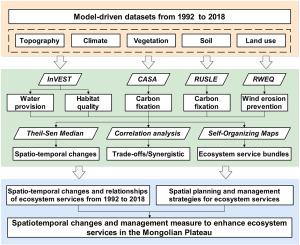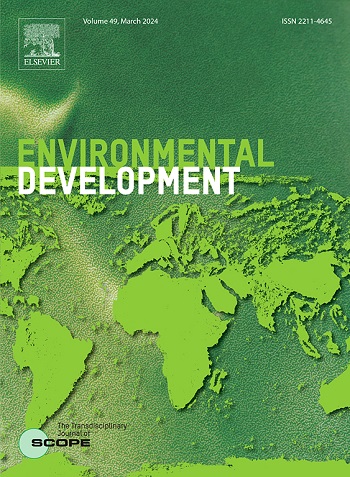Spatiotemporal changes and management measure to enhance ecosystem services in the Mongolian Plateau
IF 4.7
2区 环境科学与生态学
Q2 ENVIRONMENTAL SCIENCES
引用次数: 0
Abstract
The eco-environment in many underdeveloped areas is vulnerable. Elucidating the changes and relationships in ecosystem services (ESs) is a fundamental basis for achieving sustainable development in these regions. Utilizing multiple data sources and models, we quantified water provision (WP), habitat quality (HQ), carbon fixation (CF), soil conservation (SC), and wind erosion prevention (WEP) on the Mongolian plateau during 1992–2018. We then analyzed the spatial-temporal changes, trade-offs/synergies, and bundles relationship of these ESs. The results indicated there was high spatial variability in five ESs across the plateau, with overall higher ESs in forested areas, and grassland and cropland areas had higher WEP values. The annual mean values of WP, HQ, CF, SC, and WEP in the plateau during 1992–2018 were 27.15 mm, 0.57, 176.17 gC·m2, 48.83 t hm2, and 58.31 t hm2, respectively. Due to fluctuations in precipitation, vegetation cover and land use, the five ESs decreased from 1992 to 2000s, but increased from 2000s to 2018, Notably, the HQ changed most significantly (p < 0.01), while the WP changed insignificantly (p > 0.05). The different ESs on the plateau overall exhibited synergistic effects, trade-offs between several pairs of ESs related to HQ, were observed in cropland areas. We further identified five distinct categories of ES bundles and proposed targeted recommendations for spatial planning and management of these ESs, tailored to their characteristics. The findings offer a valuable reference for high-quality environmental management, as well as the restoration and enhancement of ESs in arid inland areas in a warming climate.

蒙古高原的时空变化和加强生态系统服务的管理措施
许多欠发达地区的生态环境十分脆弱。阐明生态系统服务(ES)的变化和关系是这些地区实现可持续发展的基础。利用多种数据源和模型,我们对 1992-2018 年间蒙古高原的水供应(WP)、栖息地质量(HQ)、碳固定(CF)、土壤保持(SC)和风蚀预防(WEP)进行了量化。然后,我们分析了这些生态系统服务的时空变化、权衡/协同作用以及捆绑关系。结果表明,在整个高原上,五项环境因子的空间变化很大,森林地区的环境因子总体较高,而草地和耕地地区的 WEP 值较高。1992-2018年期间,高原的WP、HQ、CF、SC和WEP年均值分别为27.15 mm、0.57、176.17 gC-m2、48.83 t hm2和58.31 t hm2。由于降水、植被覆盖和土地利用的波动,1992-2000 年间五项 ES 均有所下降,但 2000-2018 年间又有所上升,其中 HQ 变化最为显著(p < 0.01),而 WP 变化不显著(p > 0.05)。高原上不同的生态系统服务总体上表现出协同效应,在耕地地区观察到了与 HQ 相关的几对生态系统服务之间的权衡。我们进一步确定了五类不同的生态系统束,并针对这些生态系统束的特点提出了有针对性的空间规划和管理建议。这些研究结果为高质量的环境管理以及在气候变暖条件下恢复和提高内陆干旱地区的环境质量提供了宝贵的参考。
本文章由计算机程序翻译,如有差异,请以英文原文为准。
求助全文
约1分钟内获得全文
求助全文
来源期刊

Environmental Development
Social Sciences-Geography, Planning and Development
CiteScore
8.40
自引率
1.90%
发文量
62
审稿时长
74 days
期刊介绍:
Environmental Development provides a future oriented, pro-active, authoritative source of information and learning for researchers, postgraduate students, policymakers, and managers, and bridges the gap between fundamental research and the application in management and policy practices. It stimulates the exchange and coupling of traditional scientific knowledge on the environment, with the experiential knowledge among decision makers and other stakeholders and also connects natural sciences and social and behavioral sciences. Environmental Development includes and promotes scientific work from the non-western world, and also strengthens the collaboration between the developed and developing world. Further it links environmental research to broader issues of economic and social-cultural developments, and is intended to shorten the delays between research and publication, while ensuring thorough peer review. Environmental Development also creates a forum for transnational communication, discussion and global action.
Environmental Development is open to a broad range of disciplines and authors. The journal welcomes, in particular, contributions from a younger generation of researchers, and papers expanding the frontiers of environmental sciences, pointing at new directions and innovative answers.
All submissions to Environmental Development are reviewed using the general criteria of quality, originality, precision, importance of topic and insights, clarity of exposition, which are in keeping with the journal''s aims and scope.
 求助内容:
求助内容: 应助结果提醒方式:
应助结果提醒方式:


